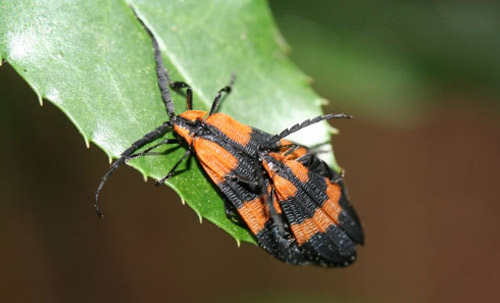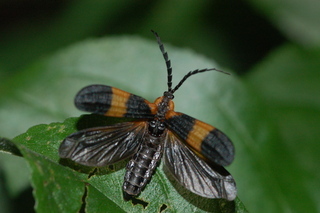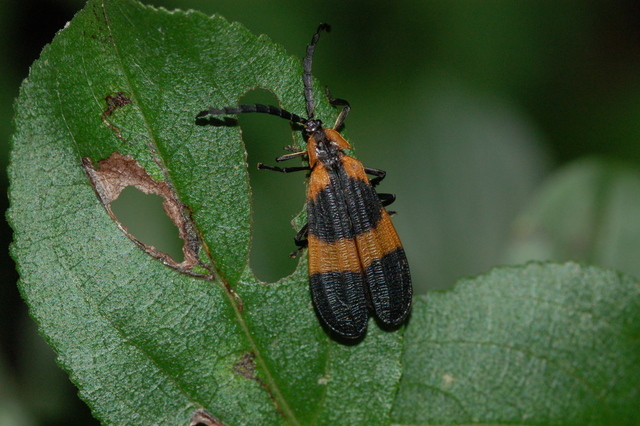What is C. reticulatum's boday structure and how does it defend itself?
General Form
All Banded Net-Winged Beetles’s have a common, general form that
is consistent throughout all members of the species. All adult
Calopteron reticulatum are elongated with wings that become
wider at the posterior end. The segment behind the head of this
beetle is black with yellow to orange sides. Of these
consistencies one that differentiates males from females is
their size. The adult males are approximately half the size of
the adult females (White1983).
Transportation Mechanisms
Organisms have various mechanisms for
transportation on land that are specialized for their
environment. Throughout some organism’s life stages, they will
have different transportation mechanisms that better suit their
body form and function.
Larvae:
In the case of Calopteron
reticulatum, transportation in the early life stage of larvae
was on six short jointed legs. The larvae would scurry around on
the forest floor looking for food.
Adult:
The adult C.
reticulatum moves around on its six jointed legs. However, the
legs of a beetle that are only ten to fifteen millimeters do not
allow the beetle to move very quickly in the presence of danger.
In order to get from place to place more rapidly, C. reticulatum
has adapted wings that allow the beetle to fly. There are three
pairs of wings with the outermost pair of wings having a unique
pattern that resembles a network by having raised ridges running
both length and width of the wing (White 186-187).
However, the
legs of a beetle that are only ten to fifteen millimeters do not
allow the beetle to move very quickly in the presence of danger.
In order to get from place to place more rapidly, C. reticulatum
has adapted wings that allow the beetle to fly. There are three
pairs of wings with the outermost pair of wings having a unique
pattern that resembles a network by having raised ridges running
both length and width of the wing (White 186-187).
Defense Mechanisms
Not only does the (bug) have various
transportation methods, but it also has defense mechanisms to
protect itself in each of its life stages. At ten to fifteen
millimeters, these larvae look fairly appetizing to some birds
or other predators; however, these beetles belong to the Lycidae
family have been found to contain chemicals that are toxic to
predators. To warn these predators that they are toxic without
the need for a taste, C. reticulatum larvae also have adapted an
orange and black patches in this stage of their lives to warn
predators (Bennett et al. 2012). This net pattern as well the
banded orange coloration help give C. reticulatum its name. The
beetle has adapted bright orange bands to warn predators of
their foul taste (Hall and Branham 2008); a taste that is comes
from the fatty as well as lycidic acids in the beetle (Bennett
et al. 2012). When a predator tastes this beetle, it spits the
beetle out and characterizes the taste with the orange color.
Some predators may not see the orange coloration of C.
reticulatum. For these predators, the beetle has developed
pyrazine, a chemical compound that produces undesirable odors.
The repugnant scent helps to deter predators. If the scent is
not detected, then the bright orange bands will let the predator
know that the beetle is not an appetizing meal.
Continue to our
Life
History/Reproduction page to learn about how the Banded
Net-Winged Beetle has evolved and reproduced.

